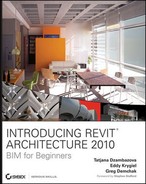Welcome to the third edition of Introducing Revit Architecture, which was written based on the 2010 release of the software.
It was great fun revisiting our first book — we worked hard to polish it up and capture the new features in the 2010 release of Revit Architecture. We enjoyed the synergy of three friends, three architects, three authors collaborating to bring this project into reality. But mostly, we were all driven by the feeling that we're doing something great: introducing Revit to those who have not been acquainted with its incredible power and its ability to put some fun back into using software and designing architecture.
This book is written for beginners who have never seen (or may have only heard about) Revit. It's for architects of any generation — you don't need to be a high-tech wizard to get into Revit. Toward that end, we wanted to make a book that is as much about architecture as it is about software. We've added many time-saving and inspiring concepts to the book to get you motivated and to help you on your journey into the new era of building information modeling (BIM). We think we've succeeded, because the book is full of real-world examples that show how to use Revit practically and creatively based on all of our experiences out there in professional practice.
This book will help you learn Revit and BIM basics easily and efficiently via straightforward explanations, real-world examples, and practical tutorials that focus squarely on accomplishing vital Revit tasks.
Our book begins with an overview of BIM concepts before introducing the Revit interface. You'll start working with basic modeling features, learning how to create walls, floors, roofs, and stairs. The book then explains how to use components and provides descriptions and examples of Revit's suite of editing tools.
The book continues by looking deeper into the capabilities of core modeling elements. We explain how Revit works with other applications, show you how to document the model for construction, and explore how you can integrate annotations into the model.
After we discuss printing to paper and files, we explore worksets and team collaboration, followed by a look at some of Revit's more advanced options. The book concludes with a chapter on troubleshooting and best practices; that's where we try to share our practical experience with you so you can avoid some of the common beginner pitfalls (and enjoy beginner's luck). Also featured is a full-color gallery containing inspirational Revit projects from around the globe.
The book's companion web page, at www.wiley.com/go/introducingrevit2010, features all the tutorial files necessary to complete the book's exercises, plus sample families and a trial version of the Revit software.
Enjoy! Revit has changed our lives. Maybe it will change yours as well.
We welcome your feedback! Please feel free to e-mail us at [email protected].
Tatjana Dzambazova
Eddy Krygiel
Greg Demchak
